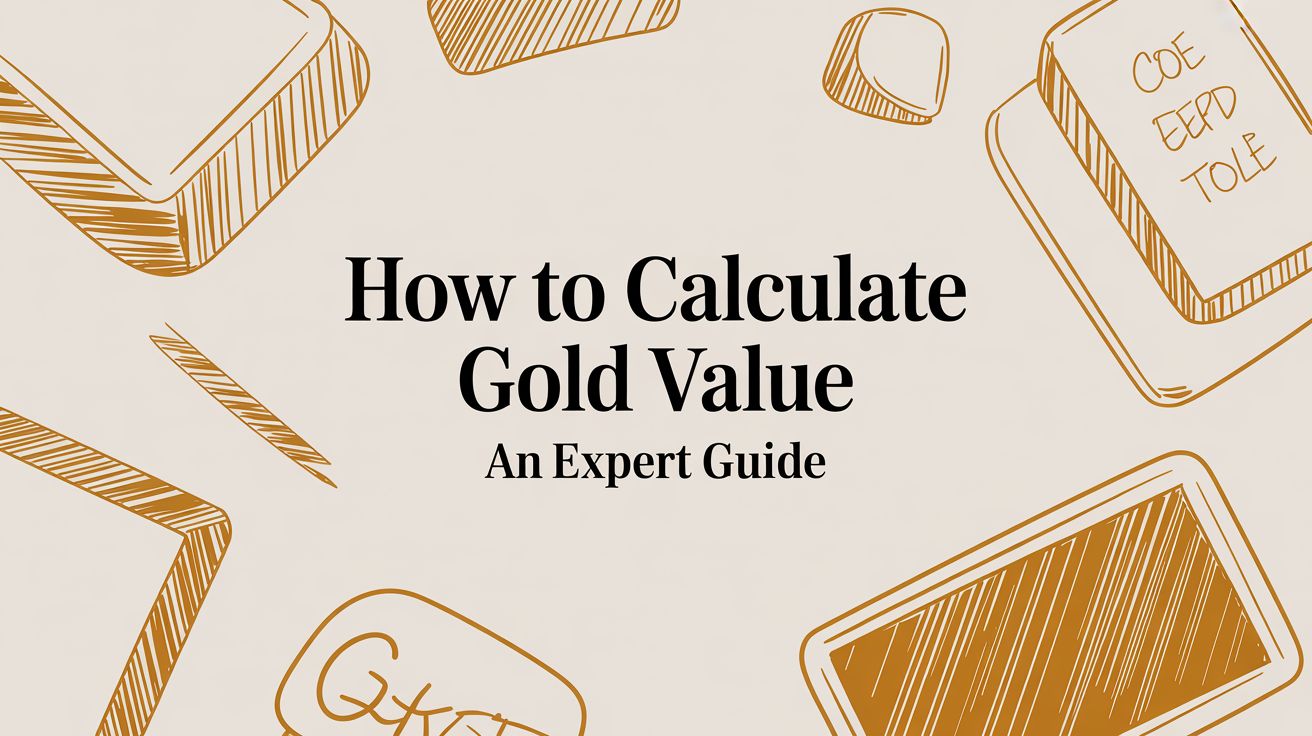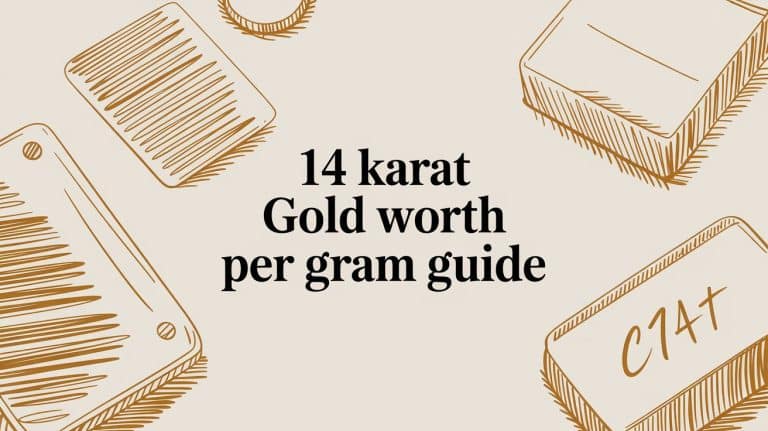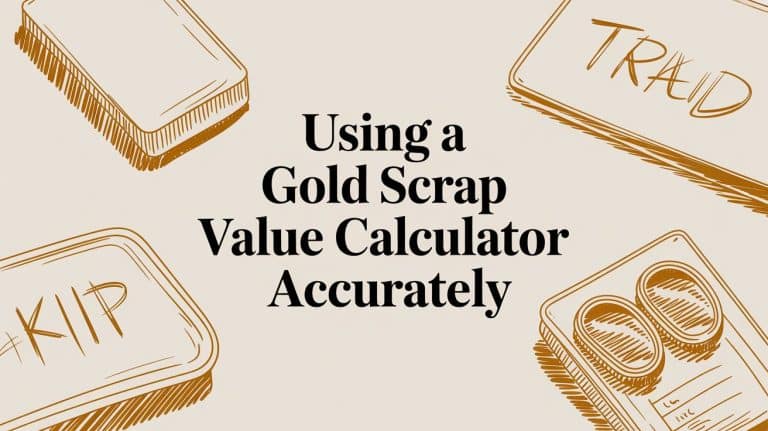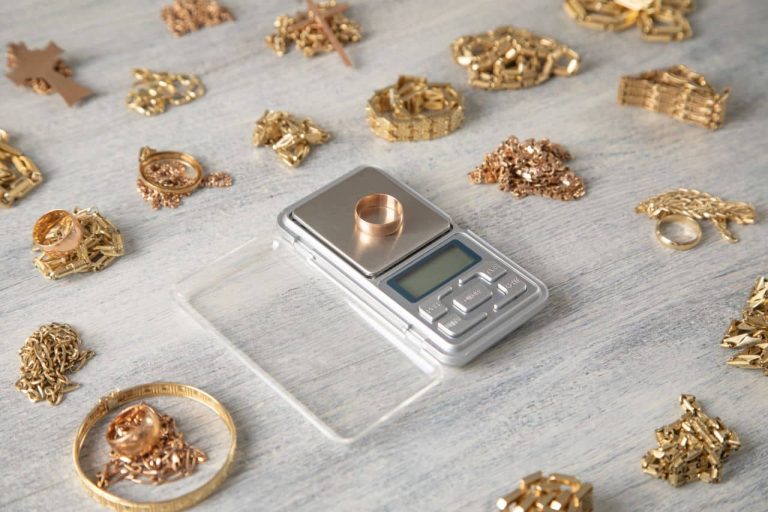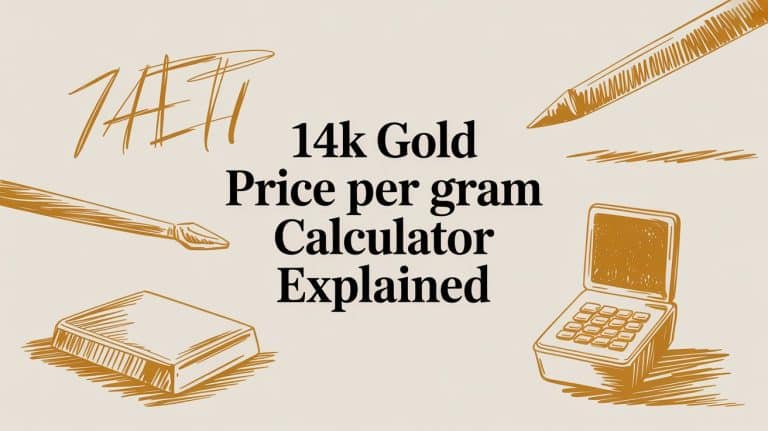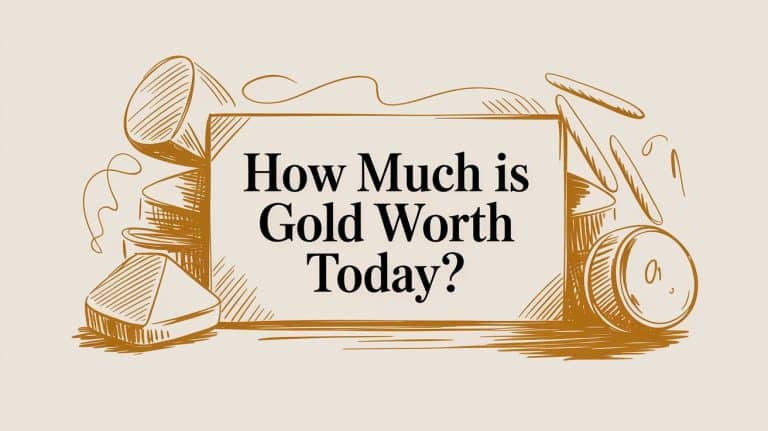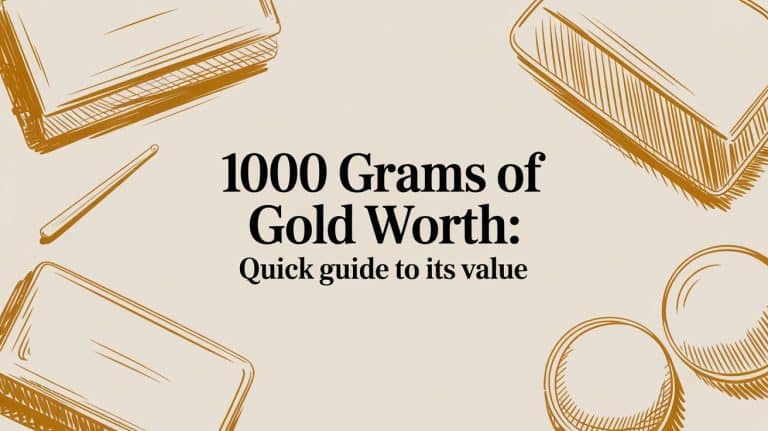How to Calculate Gold Value An Expert Guide
Ever wondered what that old gold chain or forgotten ring is really worth? Let's get straight to it. The core formula every buyer starts with is surprisingly simple: (Weight x Purity) x Current Spot Price = Melt Value. This number represents the raw, intrinsic value of the actual gold in your item, and it is the foundation for any offer you will get.
Your Quick Guide to Valuing Gold
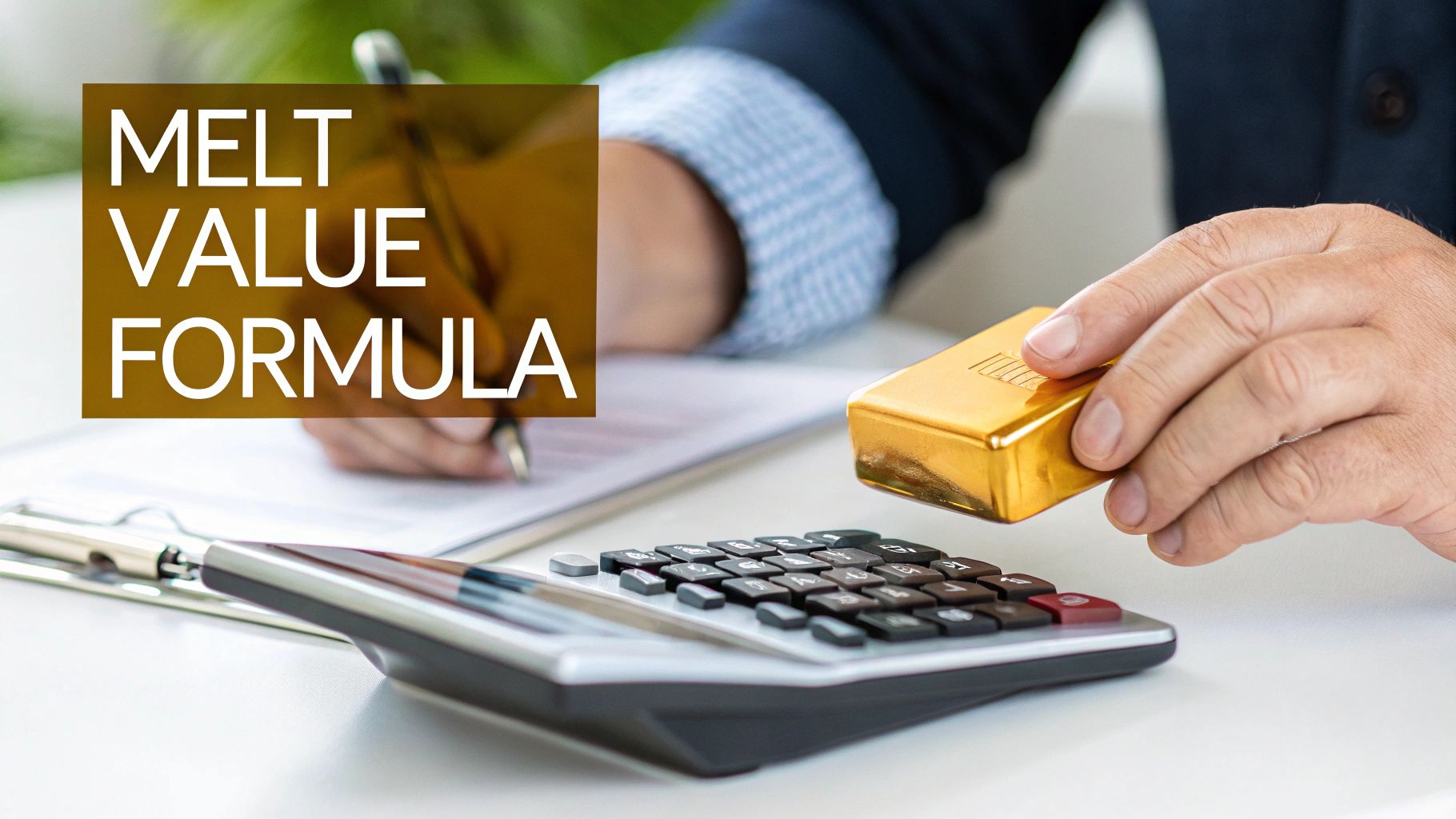
Before you can confidently figure out what a piece of gold is worth, you need a solid handle on the three elements that drive its value. I like to think of them as the three pillars of gold valuation. Getting these down is the first real step to accurately calculating gold value, whether you are looking at a family heirloom or a pile of scrap jewelry you are ready to sell.
Each of these components plays a critical, non negotiable role. If you do not know the weight, you have nothing to measure. Without understanding its purity, you do not know how much of that weight is actually gold. And without the live spot price, you can not put a real time dollar figure on it.
The Three Pillars of Gold Value
Mastering these concepts is what separates a blind guess from an educated estimate. It takes what feels like a complex appraisal and breaks it down into a simple, three part equation. The table below gives you a clear snapshot of what you need to know and why each piece of the puzzle is so important.
| Component | What It Means for You | Why It Is Critical |
|---|---|---|
| Weight | The total mass of your item, usually measured in grams (g). A basic digital kitchen scale is often good enough to get you in the ballpark. | This is your starting point. More weight usually means more value, but it is a useless number without knowing the purity. |
| Purity (Karat) | The percentage of pure gold in your item. It is marked in karats (like 14K or 18K), where 24K is 99.9% pure gold. | Most jewelry is an alloy (a mix of metals), so this tells you the actual gold content. A 10 gram 14K ring (58.3% gold) has far less gold than a 10 gram 22K ring (91.6% gold). |
| Spot Price | The live market price for one troy ounce of pure, 24K gold. This price moves all day long based on global trading. | This is the official rate that turns your gold's physical properties (weight and purity) into a specific dollar amount right now. |
Once you understand how weight, purity, and the spot price work together, you have unlocked the secret to valuing any gold item you own. It puts you in the driver's seat, allowing you to walk into any negotiation with confidence.
Decoding Gold Purity: Karats and Fineness
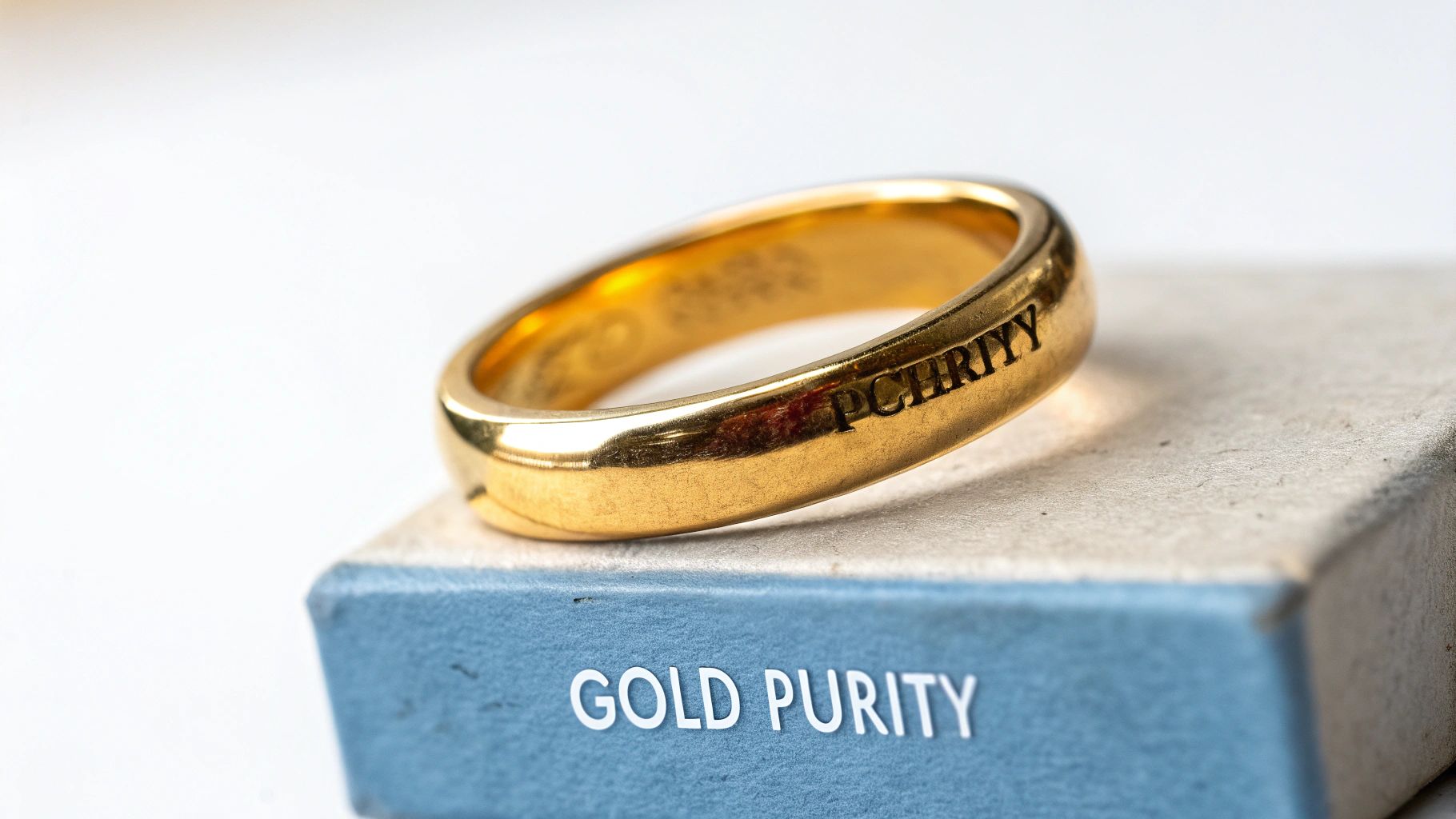
Before you can calculate your gold's value, you have to get to know the metal itself. Here’s a little secret most people do not realize: the gold in your jewelry box is almost never 100% pure.
That might sound surprising, but there is a good reason for it. Pure gold is incredibly soft. So soft, in fact, that you could easily bend a pure gold ring with your bare hands. To make it strong enough for everyday life, jewelers mix pure gold with other metals like copper, silver, or zinc. This mixture, called an alloy, is what gives your jewelry the durability to last a lifetime.
The purity of your item simply tells you the ratio of pure gold to these other alloy metals. Getting this right is the single most important step in figuring out its true melt value.
Karats: The Universal Language of Gold Purity
In the world of jewelry, the most common way to talk about gold purity is through the karat system, usually shortened to "K" or "Kt."
Think of it as a scale divided into 24 parts. If a piece is 24K gold, it means all 24 out of 24 parts are pure gold, making it 99.9% pure. This is the good stuff usually reserved for investment grade bullion, not your everyday necklace.
So, when you see an 18K stamp on a ring, it means the item is made of 18 parts pure gold and 6 parts other metals. A quick bit of math (18 divided by 24) tells you it is 75% pure gold. This logic is the industry standard and applies to every karat level.
Key Takeaway: The karat number is just a fraction out of 24. A higher karat means more pure gold, which directly translates to a higher value.
To give you a better feel for what you might have, here’s a quick rundown of the most common purities you will run into. For a deeper dive into how these alloys affect everything from strength to color, check out our guide on the differences between 14k, 18k, and 24k gold.
| Karat (K) | Gold Purity Percentage | Parts of Pure Gold | Parts of Alloy Metals | Common Uses |
|---|---|---|---|---|
| 24K | 99.9% | 24 | 0 | Investment grade bullion, coins |
| 22K | 91.6% | 22 | 2 | High end jewelry, some coins |
| 18K | 75.0% | 18 | 6 | Fine jewelry, luxury watches |
| 14K | 58.3% | 14 | 10 | The most popular choice for jewelry in the US |
| 10K | 41.7% | 10 | 14 | Durable and affordable jewelry options |
Fineness: A More Precise Measurement
While the karat system works perfectly for jewelry, you will see a different system used for investment grade gold like bars and bullion: millesimal fineness. It sounds complicated, but it’s just a way of expressing purity in parts per thousand.
A gold bar stamped "999" is 99.9% pure gold. One marked "999.9" is 99.99% pure. This system gives the extra precision needed when you are dealing with large quantities of high purity investment gold. Sometimes you will even see both systems used. A 14K ring, for example, might also be stamped with "583" to show its 58.3% purity.
How to Find Purity Marks on Your Items
So, where do you find this crucial information on your own gold items? Most commercially made gold is legally required to be stamped with a hallmark indicating its purity. These marks are often tiny and tucked away in inconspicuous spots.
You’ll probably need a magnifying glass or your phone's camera zoom to spot them. Here are the usual hiding places:
- Rings: Look on the inside of the band.
- Necklaces and Bracelets: Check the clasp or the small tag right next to it.
- Earrings: The mark is typically on the post or the earring back.
- Pendants: Examine the bail (the little loop that connects it to the chain).
Finding that "14K," "750," or "916" stamp is your golden ticket. It is the first piece of the puzzle you need to accurately calculate what your gold is worth.
Understanding the Live Gold Spot Price
First things first, let's get you set up with the most important number in the entire gold world: the live gold spot price.
Once you have a handle on purity, the spot price is the next piece of the puzzle. This is the real time market price for one troy ounce of pure, 24K gold. It’s the universal benchmark for every single gold valuation on the planet.
Think of it just like a stock price. It’s constantly moving, driven by global trading, and it is the anchor that turns your item's weight and purity into an actual dollar amount.
Where Does the Spot Price Come From?
No single person or group sets the spot price. It is a dynamic figure that comes from the massive volume of gold futures contracts traded on major exchanges like COMEX in New York and the London Bullion Market Association (LBMA). These markets are humming along nearly 24/7, which is why a price you see in the morning can be different by the afternoon.
Several powerful forces are always pushing and pulling on this price. At its core, it’s about supply and demand, but it is also heavily influenced by investor mood, inflation rates, and the strength of the U.S. dollar.
Gold has always been a classic "safe haven" asset. When the economy gets shaky or inflation spikes, investors often flock to gold, driving its price up. During the 2011 financial crisis, for example, gold prices shot up to nearly $2,000 per ounce. Central banks are also big players; according to the World Gold Council, they have been net buyers of gold since 2010, which adds steady demand to the market. You can discover more insights about gold price dynamics on Gold Avenue to get a deeper feel for these forces.
A Quick Tip: For the most accurate, up to the minute pricing, always use a reliable financial source or a dedicated tool like our Gold Calculator. We pull live data straight from the markets, so our calculations are always based on the current, precise spot price.
This constant movement is why any gold valuation is just a snapshot in time. A quote you get from a buyer is usually only good for a very short period because the underlying value is always shifting.
Troy Ounces vs. Regular Ounces
Okay, pay attention here, because this is a detail where a lot of people trip up. It is absolutely critical for getting your math right.
The gold spot price is quoted in troy ounces. This is not the same as the standard ounce (officially called an "avoirdupois" ounce) you use in the kitchen to measure flour.
Getting this distinction right is non negotiable for an accurate valuation. If you use the wrong conversion, you’ll significantly skew your numbers and end up with a wildly incorrect value.
Here’s a simple table to keep them straight:
| Unit of Measurement | Weight in Grams | Primary Use |
|---|---|---|
| Troy Ounce (ozt) | 31.103 grams | The universal standard for weighing precious metals like gold, silver, and platinum. |
| Avoirdupois Ounce (oz) | 28.35 grams | Used for everyday items, like food and postage. |
As you can see, a troy ounce is almost 10% heavier than a regular ounce. Since most people weigh their jewelry on a small digital scale that measures in grams, you will almost always need to convert the spot price from its per troy ounce value into a per gram value to do your calculation.
Converting Spot Price to a Per-Gram Price
Let's make this practical. To figure out what one gram of pure gold is worth right now, you just take the live spot price and divide it by 31.103.
Let's Run an Example
Imagine the live gold spot price is currently $2,300 per troy ounce.
- The Formula: Current Spot Price / 31.103 = Price Per Gram
- The Calculation: $2,300 / 31.103 = $73.95 per gram
This $73.95 figure is your baseline it is the value of one gram of pure, 24K gold at this very moment. This is the key number you will use in the next step to calculate the melt value of your specific item, based on its unique weight and karat. Mastering this simple conversion is the bridge from understanding the global market to finding the real world value of the gold in your hand.
Putting It All Together with a Real Example
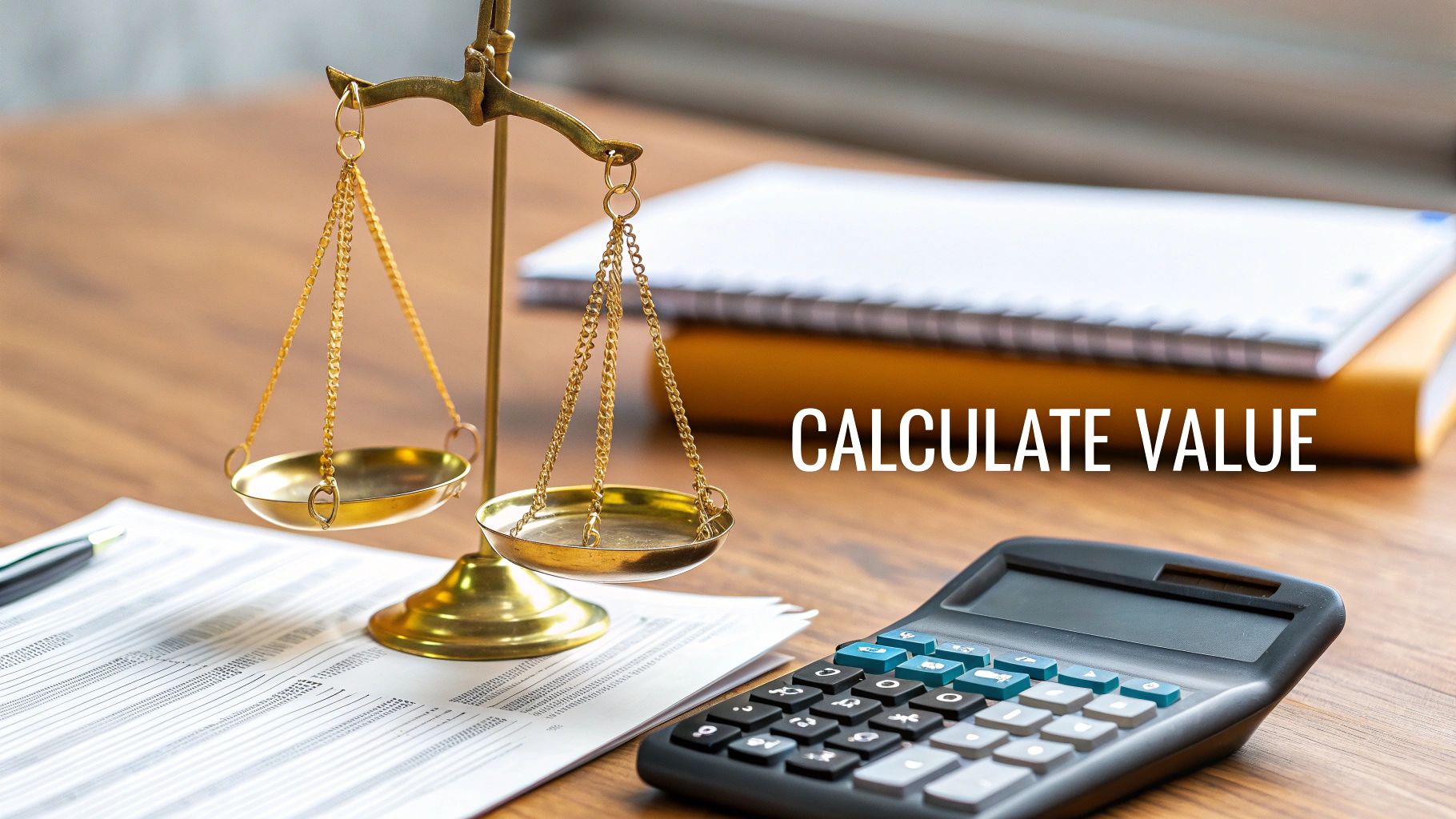
Theory is one thing, but running the numbers yourself is where it all starts to make sense. Now that you have got the concepts of weight, purity, and spot price down, let's walk through the entire process with a couple of real world scenarios. This is how you actually figure out what your gold is worth.
We will break down the exact math, step by step. Following a tangible example makes the formula much less intimidating and shows just how straightforward the calculation can be once you have the right info.
Scenario 1: Valuing a 14K Gold Chain
Let's imagine you have an old 14K gold chain. It feels solid, and you are curious what its actual melt value might be. Here’s the game plan for finding out what the gold in that chain is worth on today's market.
First up, the weight. You place it on a small digital kitchen scale, and it reads 12.5 grams. For the most accurate number, try to weigh only the chain itself, without any large pendants or non gold clasps attached.
Next, we need the purity. You find a tiny stamp on the clasp that says "14K." As we learned, 14K gold is 58.3% pure gold.
Now for the spot price. For this example, let's say the live spot price of gold is $2,320 per troy ounce.
With these three pieces of the puzzle, we can get to work.
Breaking Down the Jewelry Math
Our first move is to figure out how much pure gold is actually in the chain. We do this by simply multiplying the total weight by its purity percentage.
- Calculation: 12.5 grams (Total Weight) x 0.583 (14K Purity) = 7.29 grams of pure gold
So, your 12.5 gram chain contains just under 7.3 grams of actual, pure gold. The rest is alloyed metals that give the jewelry its strength.
The next critical step is converting the spot price from its value per troy ounce to its value per gram. This is a must do to make sure our units match up.
- Calculation: $2,320 (Spot Price) / 31.103 (Grams per Troy Ounce) = $74.60 per gram
This tells us that one gram of pure, 24K gold is worth $74.60 at this very moment.
Finally, we multiply the amount of pure gold in your chain by the current price per gram to get the final melt value.
- Final Calculation: 7.29 grams (Pure Gold Weight) x $74.60 (Price Per Gram) = $543.83
The intrinsic melt value of your 14K gold chain is $543.83. This is the foundational number any buyer would use as a starting point to make you an offer. If you want to skip the manual math, a reliable scrap gold calculator can give you an instant estimate based on live market data.
Scenario 2: Calculating a Gold Coin
Let's tackle another common one: a gold coin. Many investment grade coins are made with very high purity gold, which changes the calculation slightly.
Imagine you have a 1/4 ounce American Gold Eagle coin, a popular choice for investors.
The American Gold Eagle is minted from 22K gold, which is 91.67% pure. This alloy makes it more durable than a pure 24K coin, which is why it is so common for bullion.
Now, while the coin is labeled "1/4 ounce," this refers to the amount of pure gold it contains. The coin's total weight is actually a bit more because of the copper and silver alloy mixed in. A 1/4 oz Gold Eagle has a total weight of 8.483 grams.
Let's stick with our same spot price of $2,320 per troy ounce, which we already converted to $74.60 per gram.
Here’s how we would figure out its melt value:
- Find the Pure Gold Weight: The coin guarantees it contains exactly one quarter of a troy ounce of pure gold. Let's convert that to grams: 0.25 troy ounces x 31.103 g/ozt = 7.78 grams of pure gold.
- Multiply by the Price Per Gram: Now, we take that pure gold weight and multiply it by our per gram price.
- Final Calculation: 7.78 grams (Pure Gold Weight) x $74.60 (Price Per Gram) = $580.39
The melt value of the 1/4 oz Gold Eagle is $580.39. You might notice that this value is exactly one quarter of the full troy ounce spot price of $2,320, which confirms our math is spot on. For bullion coins like this, their value is often very close to their melt value, though some may carry a small premium based on their collectibility and condition.
What Buyers Actually Pay for Your Gold
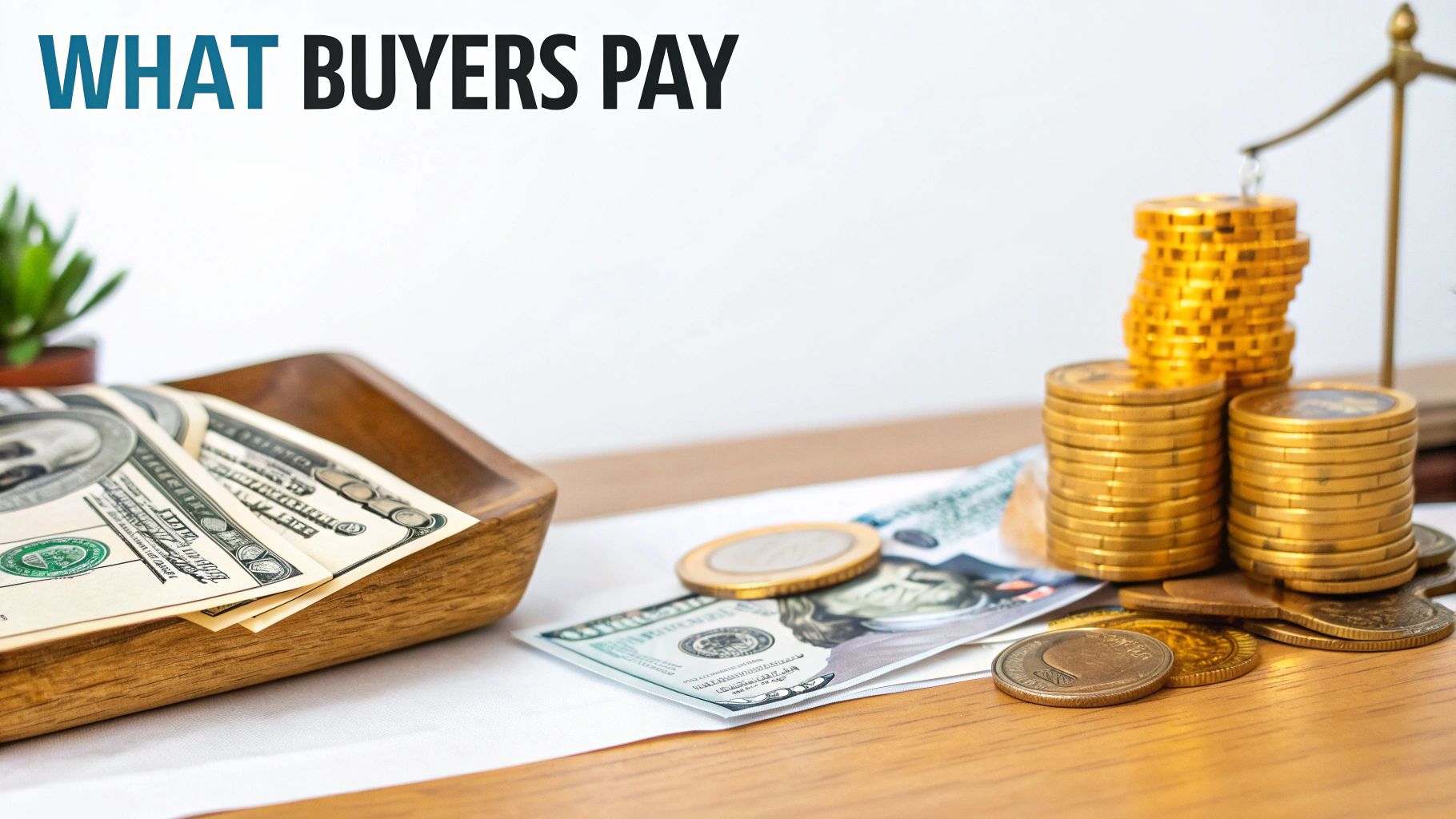
So, you have done the math and landed on a solid number: your gold's melt value. This figure is your essential starting point, representing the raw, intrinsic worth of the precious metal you are holding. But it is critical to understand that this number is not what a buyer will hand you in cash.
Think of the melt value as the sticker price on a car. It’s the benchmark for the negotiation, but it’s not the final price you will agree on. There is one last, crucial piece to the puzzle.
Why Offers Come in Below Melt Value
Gold buyers, whether they are your local jeweler, a pawn shop, or a large online refiner, are running a business. Just like any other company, they have real operational costs to cover to stay profitable and keep their doors open.
When you sell your gold, the buyer is taking on several steps and expenses behind the scenes. These costs always include:
- Testing and Verification: They have to professionally test and confirm the exact karat purity of every piece.
- Smelting and Refining: Your scrap gold items need to be melted down and put through a complex process to be refined back into pure, 24K gold.
- Business Overhead: This bucket covers everything from rent and employee salaries to insurance and security.
- Market Risk: The price of gold is constantly moving. Buyers absorb some of this risk between the time they buy from you and sell to a larger refiner.
To account for these costs and to make a profit, buyers will offer you a percentage of the total melt value. This is not a sign you are getting ripped off it is just standard industry practice.
A fair offer from a reputable buyer will typically fall somewhere between 70% and 95% of the calculated melt value. If you get an offer below this range, you should be skeptical. Offers at the highest end of the scale are usually reserved for very large quantities of gold.
Factors That Influence the Buyer's Percentage
What determines whether you get an offer closer to 70% or one pushing 95%? Several factors come into play, and knowing them gives you a much better sense of what to expect. A buyer's offer is a dynamic number, not some fixed rate they apply to everyone.
The two biggest levers that influence the percentage are the quantity and purity of the gold you are selling. It is more efficient and profitable for a buyer to process larger amounts of high purity gold, so they can often afford to offer a better rate.
Let's look at what different types of buyers might offer to see how this plays out in the real world.
| Type of Buyer | Typical Payout Percentage | Best For |
|---|---|---|
| Pawn Shops | 60% to 80% | Quick cash for single, smaller items. |
| Local Jewelers | 70% to 85% | Small to medium amounts of jewelry. |
| Online Gold Buyers | 80% to 95% | Larger quantities and scrap gold collections. |
Understanding these final adjustments is the key to setting realistic expectations. When you know a buyer's offer has their business costs baked in, you can evaluate their quote fairly. For more tips on navigating this final step, our guide on how to sell scrap gold offers practical advice for finding a trustworthy buyer and getting the best possible price. Being informed about this last part of the process empowers you to negotiate confidently and ensures you walk away feeling good about the deal.
A Few Common Questions About Gold Valuation
Even with the formula down, a few questions usually pop up. That is completely normal. When you are dealing with something as valuable as gold, getting crystal clear on the details is the best way to move forward.
Let's run through some of the most common questions people ask when they start calculating their gold's value. Nailing these down will help you avoid simple mistakes and give you real confidence in your numbers.
Does the Brand or Design Affect My Gold's Value?
This is a fantastic question and gets right to the heart of what we are calculating here. For the vast majority of gold jewelry, the value is based almost entirely on its melt value that is, the worth of the raw gold it contains. Your beautiful but unbranded 14K chain is valued the same as another unbranded 14K chain of the exact same weight.
But there’s a big exception. Pieces from iconic, high end brands like Cartier or Tiffany & Co., or genuine antique items with a unique history, can carry a "premium value" that goes way beyond their gold content.
If you suspect your item might fall into this special category, the smart move is to get it appraised by a certified jeweler who specializes in estate or vintage pieces. The methods in this guide are perfect for finding the intrinsic gold value the baseline for every item but they do not account for brand prestige or historical importance.
Why Is the Gold Spot Price Always Changing?
The gold spot price is in constant motion because gold is traded on global markets nearly 24/7. It helps to think of it like a stock price that reacts instantly to what is happening in the world.
Its value is swayed by a powerful mix of factors:
- Economic Data: Reports on inflation, employment numbers, and economic growth can make investors nervous or confident, pushing them toward or away from the safety of gold.
- Geopolitical Events: Global instability or conflict often sends investors scrambling for gold as a "safe haven" asset, which drives its price up.
- Currency Fluctuations: Gold is priced in U.S. dollars. So, when the dollar weakens, it often takes more dollars to buy an ounce of gold, causing its price to rise.
This nonstop activity is why any valuation is just a snapshot in time. The price you see in the morning could easily be different by the afternoon, which is why buyers often give quotes that are only valid for a very short period.
Pro Tip: Never, ever rely on a gold price you saw last week. For any serious calculation, always use a live, up to the minute spot price from a trusted source. It’s the only way to ensure your numbers are accurate.
Troy Ounce vs. Regular Ounce: What's the Difference?
Getting this right is absolutely critical and, honestly, one of the most common slip ups people make. A regular "avoirdupois" ounce, which we use for things like food at the grocery store, weighs 28.35 grams. A troy ounce, the universal standard for precious metals, is quite a bit heavier at 31.103 grams.
Gold spot prices are almost always quoted per troy ounce. If you use the wrong unit, you will throw off your entire calculation by nearly 10% a major miscalculation of your gold’s value.
To keep it simple, here’s a breakdown of the units you will run into.
| Unit of Measurement | Weight in Grams | When to Use It |
|---|---|---|
| Troy Ounce (ozt) | 31.103 grams | This is the official unit for the gold spot price. |
| Gram (g) | 1 gram | This is what you will use to weigh your jewelry and calculate its value. |
| Pennyweight (dwt) | 1.555 grams | An older unit some jewelers still use; it is 1/20th of a troy ounce. |
Always, always make sure you convert the spot price from its price per troy ounce into a price per gram before you multiply it by your item's weight. It’s a simple division (Spot Price / 31.103), but it is the single most important piece of math in the whole process.
Ready to skip the manual math and get a precise, real time estimate? The Gold Calculator provides instant valuations based on live market data, updated every five minutes. Get your free, accurate gold value at https://thegoldcalculator.com today.


